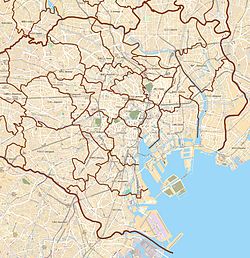Meguro Station
Railway and metro station in Tokyo, Japan From Wikipedia, the free encyclopedia
Meguro Station (目黒駅, Meguro-eki) is a railway station in the Kamiōsaki district of Shinagawa, Tokyo, close to the boundary with Meguro ward.
JY22 MG01 N01 I01 Meguro Station 目黒駅 | |||||||||||||||||||||||||||||||||||||||||||||||
|---|---|---|---|---|---|---|---|---|---|---|---|---|---|---|---|---|---|---|---|---|---|---|---|---|---|---|---|---|---|---|---|---|---|---|---|---|---|---|---|---|---|---|---|---|---|---|---|
 The main entrance in January 2018 | |||||||||||||||||||||||||||||||||||||||||||||||
| Japanese name | |||||||||||||||||||||||||||||||||||||||||||||||
| Shinjitai | 目黒駅 | ||||||||||||||||||||||||||||||||||||||||||||||
| Kyūjitai | 目黑驛 | ||||||||||||||||||||||||||||||||||||||||||||||
| Hiragana | めぐろえき | ||||||||||||||||||||||||||||||||||||||||||||||
| General information | |||||||||||||||||||||||||||||||||||||||||||||||
| Location | Kamiōsaki, Shinagawa, Tokyo Japan | ||||||||||||||||||||||||||||||||||||||||||||||
| Coordinates | 35°38′02″N 139°42′58″E | ||||||||||||||||||||||||||||||||||||||||||||||
| Operated by | Yamanote Line: JR East Meguro, Mita and Namboku Lines: Tokyo Metro Tōkyū Railways (manager) Toei Subway | ||||||||||||||||||||||||||||||||||||||||||||||
| Line(s) |
| ||||||||||||||||||||||||||||||||||||||||||||||
| Platforms | 2 island platforms | ||||||||||||||||||||||||||||||||||||||||||||||
| Tracks | 4 | ||||||||||||||||||||||||||||||||||||||||||||||
| Other information | |||||||||||||||||||||||||||||||||||||||||||||||
| Station code |
| ||||||||||||||||||||||||||||||||||||||||||||||
| History | |||||||||||||||||||||||||||||||||||||||||||||||
| Opened | 16 March 1885 | ||||||||||||||||||||||||||||||||||||||||||||||
| |||||||||||||||||||||||||||||||||||||||||||||||
| |||||||||||||||||||||||||||||||||||||||||||||||
Lines
Meguro Station is served by the following lines:
- East Japan Railway Company (JR East) Yamanote Line
- Tokyo Metro Namboku Line - through service with Tokyu Meguro Line
- Toei Mita Line - through service with Tokyu Meguro Line
- Tokyu Meguro Line - through service with Tokyo Metro Namboku Line and Toei Mita Line
Station layout
The JR East part of the station consists of one island platform serving two tracks. It also has a "Midori no Madoguchi" staffed ticket office and a View Plaza travel agency. The combined Tokyu, Tokyo Metro, and Toei part of the station consists of an island platform located on the 4th basement ("4BF") level.
JR East platforms
| 1 | JY Yamanote Line | for Shinagawa and Tokyo |
| 2 | JY Yamanote Line | for Shibuya, Shinjuku, and Ikebukuro |
- JR East ticket gates, 2019
- The Yamanote Line platforms in April 2021
Tokyu/Toei/Tokyo Metro platforms
| 1 | MG Meguro Line | for Musashi-Kosugi, Hiyoshi, and Shin-Yokohama
|
| 2 | I Mita Line | for Otemachi, Suidobashi, Nishi-Takashimadaira |
| N Namboku Line | for Iidabashi, Akabane-Iwabuchi SR Saitama Rapid Railway Line for Urawa-Misono |
- Tokyu/Tokyo Metro/Toei ticket gates, 2016
- Tokyu/Tokyo Metro/Toei Platforms, 2018
History
The JR East station (originally Nippon Railway station) opened on 16 March 1885.[1] The Namboku Line and Mita Line subway station opened on 26 September 2000.[2]
The station facilities of the Namboku Line were inherited by Tokyo Metro after the privatization of the Teito Rapid Transit Authority (TRTA) in 2004.[3]
Half-height platform edge doors were installed on the two Yamanote Line platforms from 28 August 2010.[4]
Station numbering was introduced to the JR East platforms in 2016 with Meguro being assigned station number "JY22".[5][6]
Passenger statistics
In fiscal 2013, the JR East station was used by an average of 106,538 passengers daily (boarding passengers only), making it the 31st-busiest JR East station.[7] Over the same fiscal year, the Tokyu station was used by an average of 248,074 passengers daily, making it the busiest station on the Meguro Line.[8] In fiscal 2013, the Toei station was used by an average of 42,647 passengers daily (boarding passengers only).[9] In fiscal 2013, the Tokyo Metro station was used by an average of 102,998 passengers daily. Note that the statistics consider passengers who travel through Meguro station on a through service as users of the station, even if they did not disembark at the station.[10]
The daily passenger figures for JR East, Tokyu and Tokyo Metro in previous years are as shown below.
- Note that JR East figures are for boarding passengers only.
See also
References
External links
Wikiwand - on
Seamless Wikipedia browsing. On steroids.








